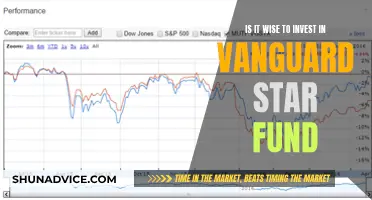
Debt funds are a type of mutual fund that generates returns by lending money to governments and companies. The lending duration and the type of borrower determine the risk level of a debt fund. Debt funds can be considered for an investment horizon of one day to up to three years. With rising interest rates, investors may be wondering which debt funds to invest in. Long-duration debt fund investments are not profitable when interest rates are on the rise. Instead, investors should consider short-duration debt funds, as the impact of interest rate risk is lower on short-term fixed-income securities. Ultra-short-duration debt funds, floating-rate funds, and fixed maturity plans are some options for investors to consider.
Which debt funds to invest in rising interest rates?
| Characteristics | Values |
|---|---|
| Short-term debt funds | Better during rising interest rate scenarios |
| Ultra-short-term mutual funds | For an investment horizon of 6-12 months |
| Money market funds | For an investment period of one to two years |
| Short-term debt funds | For an investment horizon of two years and above |
| Corporate bond funds | For an investment horizon of two years and above |
| Liquid funds | To park your emergency funds |
| Overnight funds | Safest among debt funds |
| Floating-rate funds | Returns increase with rising interest rates |
| Fixed maturity plans | No interest risk |
What You'll Learn

Short-term debt funds
When interest rates rise, the value of existing long-term debt investments falls as newer issues of bonds for the same tenure will carry higher interest rates, thus causing a decline in demand. However, this impact is lower for short-term debt papers due to lower price fluctuations. Therefore, debt funds investing in short-term papers are likely to perform better when interest rates are rising.
When considering short-term debt funds, pay attention to the fund's expense ratio or fee. A lower expense ratio is generally preferable as it results in higher returns for the investor. Additionally, evaluate the fund's parameters, credit rating, and lending duration to ensure they align with your risk tolerance and investment objectives.
How to Choose a Qualified Opportunity Fund for Investing
You may want to see also

Floating-rate funds
One of the key advantages of floating-rate funds is their lower sensitivity to changes in interest rates compared to fixed-rate investments. As interest rates rise, the income generated by floating-rate funds also increases, making them attractive to investors seeking to boost the yield of their portfolios. Additionally, these funds have a relatively lower duration than other fixed-income mutual funds, allowing them to more effectively navigate changing interest rate environments.
However, it is important to note that floating-rate funds are not without risk. They often invest in below-investment-grade securities, and there is a chance of default, especially during economic downturns. Investors should carefully evaluate the riskiness of a fund's portfolio before investing. While floating-rate funds can provide diversification benefits, their performance is linked to the broader economy. If economic conditions deteriorate, the risk of default increases, which can negatively impact the fund's performance.
Retirement Mutual Funds: Where to Invest for a Secure Future
You may want to see also

Ultra-short-term debt funds
These funds are ideal for investors looking to invest for shorter durations with low risk and earn reasonable dividends. The average rate of returns for these funds ranges between 7% and 9%. Ultra-short-term debt funds are perfect for investors who wish to meet their financial goals within six months.
Ultra-short-term funds offer a higher level of liquidity than any other class of investment funds with long-term tenure. The typical investment horizon for these funds ranges from a week to about 18 months. They are suitable for investors who want to park their surplus funds for one to nine months and earn dividends.
However, ultra-short-term debt funds are not without risk. They are riskier compared to liquid funds. The fund manager's investment strategy may introduce credit risk when low-credit-rated securities are incorporated in the expectation of an upgrade in the future. Additionally, the introduction of government securities may increase the fund's volatility more than expected.
The Net Asset Value (NAV) of these funds tends to drop with a rise in the overall interest rates in the economy, so they are suitable for a falling-interest-rate regime. Ultra-short-term debt funds charge a fee called an expense ratio to manage your investment. SEBI has set the upper limit for this ratio at 1.05%. Considering the overall returns generated by these funds, a long-term holding period and a lower expense ratio will help recover money in the event of interest rate fluctuations.
Ultra-short-term funds are ideal when you need to keep money invested for a few weeks or months but require liquidity. They offer negligible risk of loss if you extend the holding period over three months and provide higher returns than fixed deposits with banks.
UK Index Funds: Where to Invest Your Money Wisely
You may want to see also

Money market debt funds
Money market funds are fixed-income mutual funds that invest in short-term debt securities with very low credit risk. They are open-ended funds, meaning they can sell an unlimited number of shares to customers. The funds sell and redeem shares at a price equivalent to the net asset value (NAV), calculated daily.
Money market funds aim to maintain a $1 per share NAV using special pricing and valuation conventions. Some funds allow their NAV to float based on the market value of their securities. These funds are considered very safe, with investors' money going into cash, US government securities, or repurchase agreements (repos) collateralized by cash or government securities.
Money market funds are also highly liquid, but some impose liquidity fees on redemption and limitations on redemption periods. They are not insured by the Federal Deposit Insurance Corporation (FDIC), unlike savings accounts and money market accounts (MMAs) offered by banks and credit unions.
With rising interest rates, money market funds have become more attractive to investors. As of October 2024, the 100 largest money market mutual funds offered a 5.13% average yield, compared to 0.45% for the average savings account. This has led to record inflows into money market funds, with investors pouring in a net $152.7 billion in May 2024, pushing total assets to $5.8 trillion.
- Fidelity Money Market Fund (SPRXX)
- Schwab Value Advantage Money Fund Investor (SWVXX)
- T. Rowe Price U.S. Treasury Money Fund Z (PRTXX)
- Invesco Premier Portfolio Institutional (IPPXX)
- JPMorgan Liquid Assets Money Market Fund (MJLXX)
- Vanguard Federal Money Market Fund (VMFXX)
- Fidelity Government Money Market Fund (SPAXX)
- Vanguard Treasury Money Market Fund (VUSXX)
- T. Rowe Price Government Money Fund (PRRXX)
- BlackRock Wealth Liquid Environmentally Aware Fund Investor (PINXX)
Mutual Funds: Where to Invest for Maximum Returns
You may want to see also

Fixed maturity plans
FMPs are ideal for investors seeking predictable returns and are willing to have their money locked in until the fund matures. While FMPs are not entirely risk-free, they offer a more stable option compared to other investments. The net asset value (NAV) of FMPs can vary with interest rate changes and economic factors, so investors should be aware of the duration before committing.
FMPs are taxed differently from fixed deposits. Dividends are added to the investor's overall income and taxed according to their income tax slab. Short-term capital gains, realised within three years, are taxed at the applicable slab rate. Long-term capital gains, after holding for more than three years, are taxed at a rate of 20% after indexation.
FMPs are a good option in a rising interest rate environment as they don't carry any interest rate risk. However, investors need to be comfortable with the lock-in period until the scheme's maturity.
NHCU's Investment Strategies: Where Are Funds Allocated?
You may want to see also
Frequently asked questions
Debt funds are among the least risky types of mutual funds, but they are not risk-free. Investors need to be mindful of interest rate risk and credit risk. An unexpected increase in rates can wipe out months of capital gains, especially for long-duration funds. Credit risk arises due to the possibility of default on interest and principal payments by the bonds held by the debt fund.
Overnight Funds and Liquid Funds are examples of Debt Funds with extremely low risk. The Overnight Fund is the safest as it invests in securities that are maturing in one day, so they don't carry any credit or interest risk. Liquid Funds are also among the safest categories as they can only invest in debt and money market securities with maturities of up to 91 days, reducing the interest rate and credit risk.
Short-term and ultra-short-term debt funds are considered better options during rising interest rates. Ultra-short duration debt funds invest in fixed-income securities with a duration of three to six months, ranging from treasury bills to short-term bonds. Floating-rate funds are another option, as they invest in debt securities with variable interest rates, so returns increase when interest rates rise.







